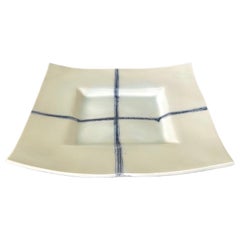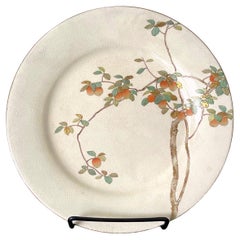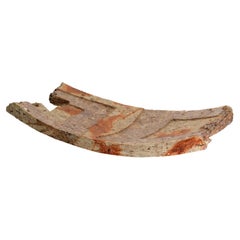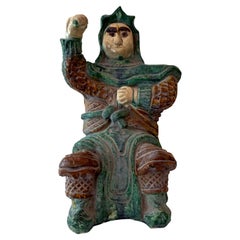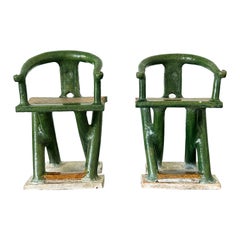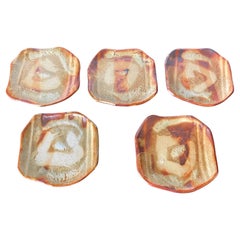Georgia - Ceramics
to
25
316
1,986
1,348
293
23
41
1
1
117
92
84
23
38
12
17
12
2
1
2
2
2
313
73
11
10
7
288
277
125
76
76
316
316
316
27
11
10
3
3
Item Ships From: Georgia
Japanese Contemporary Ceramic Plate Yoshikawa Masamichi
Located in Atlanta, GA
A ceramic square plate with white-celadon glaze by Japanese potter Yoshikawa Masamichi (1946-). The sharp-edged plate features a concaved center an...
Category
Early 2000s Japanese Modern Georgia - Ceramics
Materials
Ceramic
Fine Japanese Ceramic Plate by Kinkozan for Yamanaka & Co.
By Kinkozan
Located in Atlanta, GA
A fine Japanese ceramic satsuma plate made by Kinkozan and retailed by Yamanaka & Co. circa 1900-20s (late Meiji to early Tasho Period). The cream-color glazed plate features a very fine decoration of a persimmon tree bearing fruits. The composition is poetic, stylized but also realistic, with a literati painter's quality, and was advantageously enhanced by the enamel colorings in incredible details. The mastership of the medium came through the piece. It is signed on the base in gilt kanji seal (Made by Kinkozan) and branded Yamanaka & Co in English. The plate was likely commissioned by the company from Kinkozan for its various galleries in US and Europe.
The Kinkozan family established their pottery business first in 1645 and by the end of 19th century, it had become the largest studio producer of Satsuma ware. By the 1850s, Kinkozan Sobei...
Category
Early 20th Century Japanese Meiji Georgia - Ceramics
Materials
Ceramic
Ceramic Sculptural Centerpiece by Ryuichi Kakurezaki
By Kakurezaki Ryuichi
Located in Atlanta, GA
A large and bespoken stoneware centerpiece platter in sculptural form by Japanese ceramic artist Ryuichi Kakurezaki (1950-) circa 2000s. Made in Bizen ware tradition in a thick slab ...
Category
Early 2000s Japanese Modern Georgia - Ceramics
Materials
Ceramic
Chinese Ceramic Glazed Guardian Ming Dynasty
Located in Atlanta, GA
A stoneware figure depicting a seated armored warrior with a striking pose circa 15th-17th century. He is likely one of the four heavenly kings, th...
Category
16th Century Chinese Ming Antique Georgia - Ceramics
Materials
Stoneware
Pair of Chinese Ming Dynasty Tomb Funeral Pottery Chair Models
Located in Atlanta, GA
A pair of Chinese stoneware horseshoe cross chairs circa Ming dynasty (15th-17th century). The miniature models were traditionally made as burial offeri...
Category
16th Century Chinese Ming Antique Georgia - Ceramics
Materials
Stoneware
Set of Five Yohen-Kin Shino Ceramic Plates by Suzuki Tomio
Located in Atlanta, GA
Japanese ceramic Suzuki Tomio (born in 1948) specializes in Shino ware. In 2003, he successfully developed Yohen-kin or transformed gold Shino, an opulent and golden glaze which led to a number of luster glazes in the artist’s growing body of work. Inspired by the golden tea ceremony room in Osaka Castle commissioned by Toyotomi Hideyoshi (1536-1598) where honored guests were served tea from a glittering bowl coated with pure gold, it took the artist nearly a decade of experimentation and refinement to achieve the glaze while strictly adhering to traditional shino making techniques.
This set of five Yohen-kin plates displays a lustrous transformation. Signed on the bottom of plates. With original wrap cloth and the storage tomobako box entitled and signed by the artist in Kanji, with additional red seal. The size of the box is 5-1/8 x 8-1/4 x 8-1/4 inches.
Many of Suzuki Tomio's shino pottery...
Category
Early 2000s Japanese Organic Modern Georgia - Ceramics
Materials
Ceramic
Japanese Ceramic Dish Meiji Ogata Kenzan
Located in Atlanta, GA
A Japanese ceramic shallow dish in square form with rounded corners from Meiji period in the style of Ogata Kenzan. The dish features a cream color crackl...
Category
19th Century Japanese Meiji Antique Georgia - Ceramics
Materials
Ceramic
Tall Korean Ceramic Storage Jar Joseon Dynasty
Located in Atlanta, GA
A Korean ceramic storage jar circa 18th century of Joseon Dynasty. The jar is of a classic Maebyong form (known in Chinese as Plum Vase or Meiping...
Category
18th Century Korean Other Antique Georgia - Ceramics
Materials
Ceramic
Near Pair of Antique Japanese Arita Export Ceramic Jars
Located in Atlanta, GA
A near pair Hizen pottery jars from Artia Japan, circa mid-19th century of the Meiji Era. Heavy stoneware construction with overglaze enamels that was inspired by Chinese WuCai from ...
Category
Mid-19th Century Japanese Japonisme Antique Georgia - Ceramics
Materials
Ceramic
9 Pc, Chinese Export Porcelain Instant Starter Collection Including Armorial
Located in Atlanta, GA
Chinese, mostly 18th century.
A grouping of 9 Chinese porcelain objects including a blue and white floral bowl, a Famille rose bowl heavily enamel decorated with figural scenes, a "thousand...
A grouping of 9 Chinese porcelain objects including a blue and white floral bowl, a Famille rose bowl heavily enamel decorated with figural scenes, a "thousand...
Category
Late 18th Century Chinese Chinese Export Antique Georgia - Ceramics
Materials
Porcelain
$716 Sale Price
20% Off
Pair of 17th century porcelain boxes from the Hatcher Cargo
Located in Atlanta, GA
Pair of 17th century Chinese porcelain blue and white boxes painted with flowering branches of prunus growing from rockwork.
These tiny transitiona...
Category
1640s Chinese Antique Georgia - Ceramics
Materials
Porcelain
12th Century Song Jarlet with Deep Brown Glaze
Located in Atlanta, GA
Song jarlet with deep brown glaze, 12th century.
This small piece is all about purity of form, enhanced by the rich color of its glaze, which has a subtle crackle. The glaze, which covers almost the entire piece except for the very edge of its foot, looks like melted chocolate poured over...
Category
15th Century and Earlier Chinese Antique Georgia - Ceramics
Materials
Pottery
$450 Sale Price
51% Off
Mallet-Shaped Miniature Vase from Hatcher Collection
Located in Atlanta, GA
Miniature 17th century blue and white mallet-shaped vase.
This miniature vase was part of a hoard recovered by Captain Michael Hatcher from the wreck of a ship that sunk in the Sou...
Category
17th Century Chinese Antique Georgia - Ceramics
Materials
Porcelain
Miniature Vase from Hatcher Collection Decorated with Birds and Flowers
Located in Atlanta, GA
Miniature 17th century blue and white pear-shaped vase decorated with birds and flowers.
This miniature vase was part of a hoard recovered by Captain Michael Hatcher...
Category
17th Century Chinese Antique Georgia - Ceramics
Materials
Porcelain
Ming Jarlet with Green Glaze
Located in Atlanta, GA
Small Ming pottery jarlet with handles and a green glaze. 16th century.
This charming, somewhat rustic piece is like a miniature version of the large earthenware jars used to store ...
Category
16th Century Chinese Antique Georgia - Ceramics
Materials
Pottery
18th Century Miniature Porcelain Vase
Located in Atlanta, GA
18th Century miniature blue and white vase with celadon base and cafe au lait band, Qianlong period (1736 - 1795). Small and elegant, wit...
Category
18th Century Chinese Antique Georgia - Ceramics
Materials
Porcelain
$465 Sale Price
40% Off
Recently Viewed
View AllMore Ways To Browse
Mashiko Pottery
Japanese Imari Box
Nabeshima Porcelain
Nanking Porcelain
Japanese Ceramic Sake Bottle
Japanese Kutani Early 20th Century
Oribe Ceramics
Porcelain Japanese Statues
Hirado Porcelain
Japanese Bizen Ware Pottery
Japanese Kutani Figure
Ko Kutani
Kutani Figure
Large Asian Floor Vases
Hatcher Cargo
Korea Tea Bowl
Kutani Charger
Red Chinese Foo Dogs
